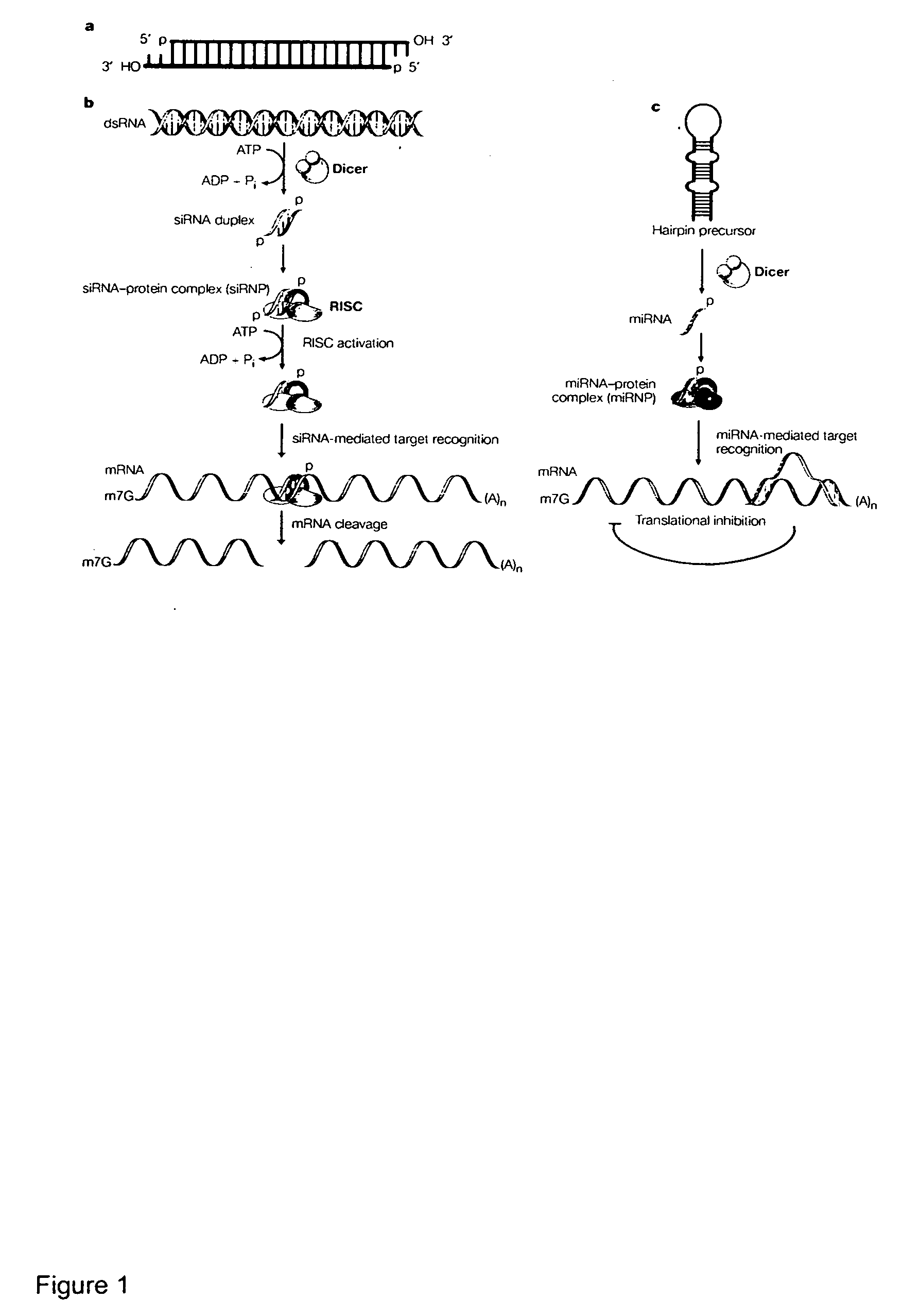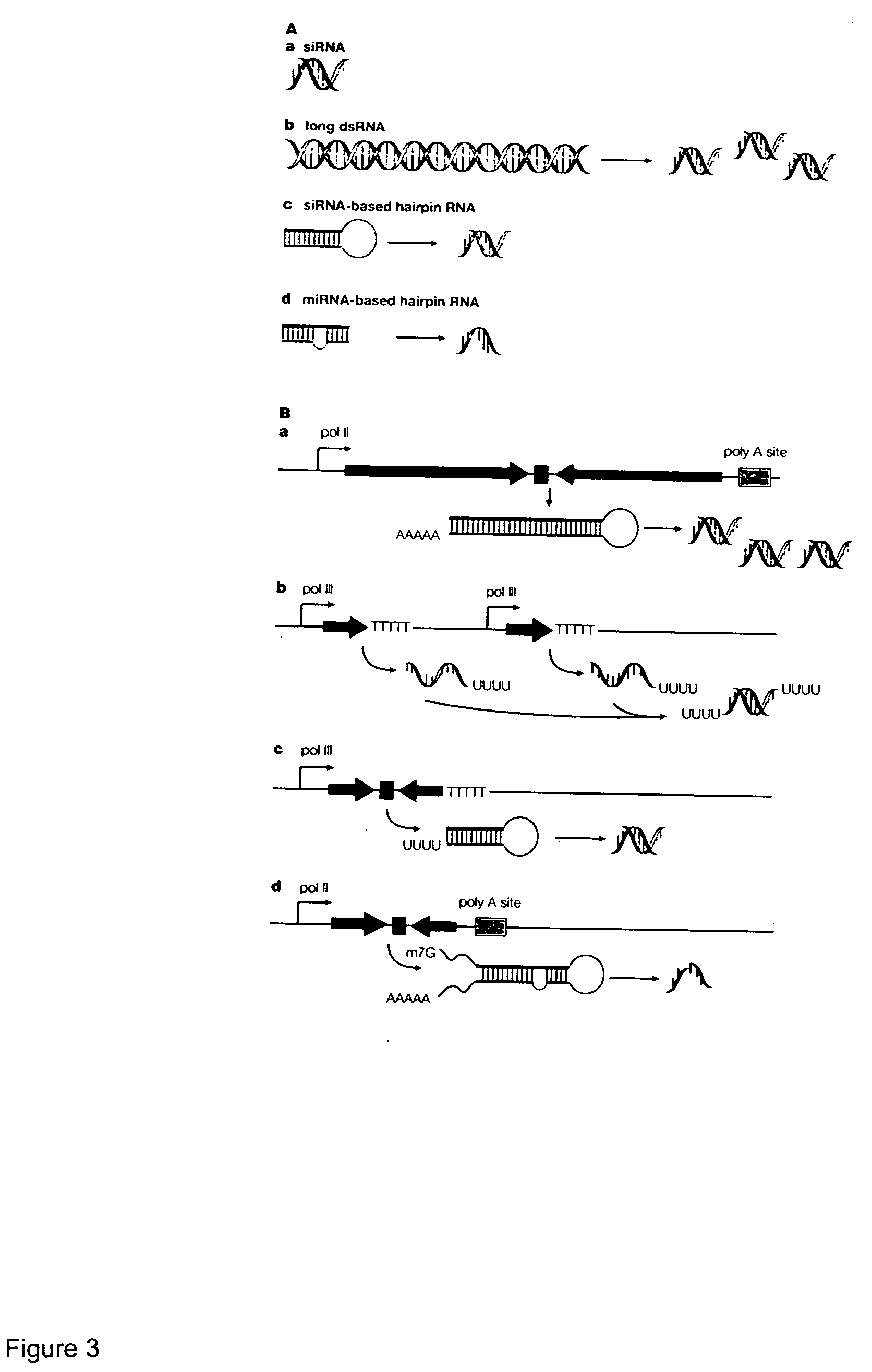Reagents and methods for identification of RNAi pathway genes and chemical modulators of RNAi
a technology of rnai pathway and chemical modulator, which is applied in the field ofreagents and methods for identification of rnai pathway genes and chemical modulators of rnai, can solve the problems of large amount of unreachable knowledge, and achieve the effects of reducing expression of detectable or selectable markers
- Summary
- Abstract
- Description
- Claims
- Application Information
AI Technical Summary
Benefits of technology
Problems solved by technology
Method used
Image
Examples
example 1
[0229] Design and construction of RNAi vectors for identification of RNAi pathway genes and chemical modulators.
[0230] Standard molecular biology techniques as described, for example, in Sambrook, et al., referenced above, were used for all cloning steps in this and other examples. As a first step toward generating vectors that mediate stable RNAi when introduced into mammalian cells, the U6 promoter was cloned into a pCDNA3.1-zeocin backbone (Invitrogen) to generate pSHARP-zeocin. The U6 promoter was similarly cloned into vector backbones that contained the hygromycin or puramycin markers, to create a versatile family of pSHARP vectors (pSHARP-zeocin, pSHARP-hygromycin, pSHARP-puramycin), into which templates for transcription of an RNAi-inducing agent of interest can be cloned. The resulting vectors were otherwise identical to pSHARP-zeocin. FIG. 7 shows the pSHARP-zeocin vector with a generic insert for transcription of an shRNA. For purposes of description members of the pSHARP...
example 2
[0237] Production and Testing of Clonal Cell Lines Expressing GFP and an shRNA That Silences GFP Expression
[0238] Experimental Procedures
[0239] Cell culture and single cell cloning. HeLa cells were grown in Dulbecco Modified Eagle medium (DMEM) plus 10% heat-inactivated fetal calf serum (FCS) containing penicillin and streptomycin at 37° C. with 5% CO2. Chinese hamster ovary (CHOk1) cells were grown in F-12 medium plus 10% heat-inactivated FCS containing penicillin and streptomycin at 37° C. with 5% CO2.
[0240] To generate stable cell lines expressing GFP, HeLa and CHOk1 cells were transfected with pdlEGFP-N1 (Clontech) using standard techniques. This vector encodes an enhanced version of the GFP protein with the PEST domain of ornithine decarboxylase at the carboxy terminus, resulting in a fusion protein with enhanced fluorescence compared with the original GFP gene and a shortened half-life of approximately 1 hour, Transfectants were selected with 500 μg / ml G418 and single cell ...
example 3
[0246] Reduction in stable gene silencing by RNAi-mediated inhibition of Dicer.
[0247] Experimental Procedures
[0248] Flow cytometry and microscopy. Flow cytometry was performed using FACScalibur and Cellquest software. Microscopy and image acquisition were performed using an Axioplan 2 microscope (Zeiss) and Axiovision Viewer 3 software (Zeiss).
[0249] Vector construction. To construct a vector (pRLL-shDCR) for silencing Dicer expression, an inverted repeat sequence with a stem sequence whose antisense strand is perfectly complementary to a portion of the human Dicer gene, followed by a five thymidine repeat sequence, was cloned 5′ of the central polypurine tract (cPPT) from pRLL-cPPT-hPGKEsin (Dull, T., et al., J. Virol., 72: 8463-8471, 1998) using the following oligomers:
DCR-1 (sense):5′-AATTCCCTCAACCAGCCACTGCTGGATTCAAGA(SEQ ID NO: 3)GATCCAGCAGTGGCTGGTTGATTTTTCTCGAG-3′DCR-2 (antisense):5′-GATCCTCGAGAAAAATCAACCAGCCACTGCTGG(SEQ ID NO: 4)ATCTCTTGAATCCAGCAGTGGCTGGTTGAGGG-3′
[0250] A...
PUM
| Property | Measurement | Unit |
|---|---|---|
| Time | aaaaa | aaaaa |
| Time | aaaaa | aaaaa |
| Electrical resistance | aaaaa | aaaaa |
Abstract
Description
Claims
Application Information
 Login to View More
Login to View More - R&D
- Intellectual Property
- Life Sciences
- Materials
- Tech Scout
- Unparalleled Data Quality
- Higher Quality Content
- 60% Fewer Hallucinations
Browse by: Latest US Patents, China's latest patents, Technical Efficacy Thesaurus, Application Domain, Technology Topic, Popular Technical Reports.
© 2025 PatSnap. All rights reserved.Legal|Privacy policy|Modern Slavery Act Transparency Statement|Sitemap|About US| Contact US: help@patsnap.com



